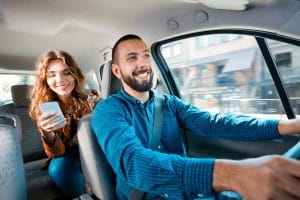Do Rideshare Services Make Roadways Safer?
 We hear a lot of anecdotal evidence that rideshare services like Uber and Lyft are making our roads safer, largely because people who are too drunk to drive aren’t getting behind the wheel as often. But given how many more vehicles are on the road now, we wondered whether or not these services were doing us any favors.
We hear a lot of anecdotal evidence that rideshare services like Uber and Lyft are making our roads safer, largely because people who are too drunk to drive aren’t getting behind the wheel as often. But given how many more vehicles are on the road now, we wondered whether or not these services were doing us any favors.
As it turns out, they might not be. Research conducted by professors from Rice University and University of Chicago School of Business showed that ridesharing services may have actually increased the number of fatal crashes across the country. Using data from the National Highway Traffic and Safety Administration Fatality Analysis Reporting System (FARS) and CrashStats, researchers “found that accidents involving a fatality increased by 2- to 4% each year, even after they controlled for other factors.”
The link, according to researcher Professor Yael V. Hochberg, is something called the “quantity effect:” more vehicles on the road, driving more miles, will lead to more accidents. These accidents can involve other drivers (for a rideshare service or not), pedestrians, public transit vehicles, motorcycle riders and cyclists – people throughout cities who may have taken public transportation, like the El or a bus, but now opt for a private ride in a vehicle instead.
If rideshare services are raising the number of accidents, should they be banned?
According to Hochberg, no – banning Uber and Lyft from operating is not a tenable solution. Instead, she suggests that municipalities and cities figure out better ways to regulate their roads: “If they are leading to more accidents and fatalities, we should be talking about engaging congestion taxes, or should we enhance safety if we don’t want to reduce the number of vehicles on the road.”
What can I do to reduce my risk of injury in a crash with an Uber or Lyft?
We don’t see ridesharing services going away any time soon, which means it is up to us to be more defensive when we’re sharing the roads.
If you are driving:
- Give rideshare vehicles a wide berth. They often make sudden stops, and drive slowly in unfamiliar areas.
- Make sure to use your turn signals to let other drivers know you are merging or turning, and keep to city speed limits.
- If you are driving the vehicle, make sure to look at your map before you start driving, so you have an idea of where you are.
- Make sure your “U” is placed in the window, so other drivers can recognize you.
If you are walking/cycling:
- Always look both ways before crossing any streets, and avoid jaywalking.
- Pay attention to traffic signals, and only cross in crosswalks.
- Stick to designated bike lanes, and make sure to use a turn signal (electronic or hand signals).
- Don’t walk or ride around while looking at your phone; distracted walking and cycling can be dangerous, too. Pull your earbuds out, too, when you’re on the road.
- Don’t assume the driver can see you. Wear reflective clothing in the morning and at night, and don’t try to walk or ride between cars.
If you or a loved one was in a crash with an Uber or Lyft vehicle in the Chicago area, Gainsberg Injury and Accident Lawyers wants to help. To schedule a free consultation with an experience Chicago car accident lawyer, please call 312-313-1621 or fill out our contact form.

Attorney Neal Gainsberg has spent the last 20+ years fighting to protect the rights of the injured in Chicago and throughout Illinois. For dedicated legal help with a personal injury, car accident, or wrongful death matter, contact Gainsberg Injury and Accident Lawyers in Chicago for a free consultation.
